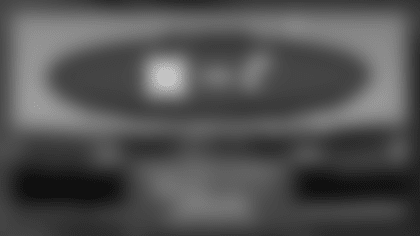**
OPENING STATEMENT:** "Good afternoon, everybody. It's kind of exciting to be here now. We're six days closer to the draft, and from a personnel guy like myself, that's an exciting time. You have an exciting time to better the organization and moving the franchise forward.
"First off, I'd like to say I'd be remiss if I didn't acknowledge a lot of people in this organization for all the hard work and time that they've done, which I think is really important. All those guys in football operations, from the personnel staff to the coaching staff, to video, to the trainers to the equipment room, it takes a lot of people to have a successful draft. And these guys, I just want to say thank you for that.
The other part was we have a good football team and I think the 2016 season plan going into it was to retain as many of our players as we possibly could. I think we did a good job with that. And we've gotten other players from other teams that are going to help move this thing forward – and that's exciting. And then you add the pieces of the draft. I know you guys are going to want me to answer questions with regards to the appeal process of the tampering case that just recently came out. But I think the interesting thing is, Clark (Hunt) made a statement for the organization Monday or Tuesday and I think that statement speaks for everybody in the organization including myself. So with that, I'm moving forward and we're moving forward as an organization. I look forward to the draft and to the season coming up because we have a good team here and that's what's good to get excited about. And with that, I'll take your questions."
Q:How does the loss of a third-round pick affect your draft strategy?
DORSEY: "I've been doing this for what, 25, 30 years. I approach every draft the same way I've ever done it. And that's the beauty of this whole thing. Every draft is different and we prepare for every scenario – whether it be round one, two-three, all the way down to seven. We have meticulously prepared ourselves to process everything and do what's best for this organization moving forward and that's kind of how I go about it."
Q:Was there hope that you were going to get the pick back?
DORSEY: "You know, I'm the eternal optimist and I look to move forward here. I think Clark's statement speaks for everybody in the entire organization and I think that's the way we should keep this. Let's get excited about this draft, let's get excited about this team and the 2016 season."
Q:When you lose a third-round pick, does that make it harder to take chances in the first or second round? Is there less room for error?
DORSEY: "Well you always want to hit. Good personnel guys want to hit their picks, that's what you do. You try to create the best options for the organization in every specific round. Who's to say right now that I would go up or who's to say right now I wouldn't go down? So you don't really know about those scenarios and those situations until after the draft. Now you can plan for those scenarios and process and think about certain things. So, strategically, at the end of the day, you want the pick or you want the player, so that's how you have to decide."
Q:Is it pre-determined what it would take, as far as value, to trade down in the draft?
DORSEY: "No, everybody uses the charts. And I think the charts, they've changed over time because evaluations of those specific picks have changed. So now there are 50 charts out there, so it all depends on who you're dealing with in terms of trades. If Adam and I were trading, let's hope Adam has the same chart that I have or else we may not get a deal together. Or you can go old school and say 'you know what, I want that player and I'll give you this, let's roll.' It comes down to two people communicating is what it comes down to."
Q:When we spoke a couple months ago we talked about going into the draft with a roster that was fairly complete, that you may be able to play a game with that roster. Do you feel like you're at that point now or not?
DORSEY: "I think we have a good football team. With that being said, you're in the system another year. We really try to retain as many good players as we can and we stuck with that philosophy and did a good job. But I think, also, we acquired people and players that are going to help this organization move forward. And then all of a sudden you sprinkle in the draft class of 2016. We're in our fourth year as far as in the draft and I think we have begun to build that foundation we talked about and now you want to add that depth, that competitive depth. There's nothing better than going into training camp having everybody competing for roles on this team. To me, that's what good teams do."

Q:How do unexpected losses like Husain Abdullah and Mike DeVito affect your draft?
DORSEY: "I don't think it affects your draft, I think what you have to do is first off you analyze the draft and the draft class that's there, its strengths and its weaknesses. And you feel – okay, can this guy help us down the road in year one, two or three, you have to project that. And then all of a sudden you look at certain positions. There's not very many people that can nail and say right now who the 28th pick in the draft is going to be. It's hard, it's hard to do that. Now you can get a pool of guys in there – two, three, four guys – and you might think that happens, but anything can happen in a split moment. I've seen times when you're sitting there and you've got the card of the player you think you're going to get and all of a sudden somebody in front of you takes him. So until you're on the clock, you really don't know for sure."
Q:How many first-round talents would you say are in this draft?
DORSEY: "I think this is a unique draft class. Again, we've always said, draft classes are uniquely different year in and year out. I think the strength of this draft will be – you could say a number from one to 12, and then all of a sudden you can then blend that number in here from I'd say 13 to 30 and then you could take it 31 down to about 60. That's how I kind of analyze, I analyze pockets."
Q:So the top-13 is where you feel the top-shelf talent is?
DORSEY: "But that's not to say – you're taking different levels now. We're talking difference-makers, serious playmakers. This is a good draft, it's a deep class. You have to remember, I think that the draft has shown it, you can acquire starters anywhere throughout the seven rounds of this thing, you can even acquire starters, if you really want to, in free agency. You just have to be very selective and you have to watch with a steady eye to see if you can acquire those players."
Q:Looking at cornerback, is there a number of guys you feel like you need to go into a game with?
DORSEY: "I think the game of football has changed and evolved more into a passing (game), probably in the last five years. So now, not only are you going vertical, you're going horizontal and vertical. I think you see the different packages that are now being installed by defensive coordinators. And I think it is important to have as many good defensive backs on your team as you possibly can have. And that's not taking away from the base package, the defensive linemen, some of the linebackers. I think that's why you're now starting to see some of your conventional inside backers that are now bigger safeties evolving into that package, a la – if you go to Arizona, they have a safety that's evolved now. And Bob Sutton runs that same scheme as well."
Q:How strong is this year's quarterback class?
DORSEY: "Well I think the last two weeks has kind of shown everybody who loves football and the National Football League, when there are two supposed franchise quarterbacks there – teams are going to race up there and give everything away to get that franchise quarterback. And if you really do your studying, it all depends – who's to say, would you like to be the guy receiving all the picks or would you like to be the team receiving the quarterback. I think you always take the player over the quarterback, but you better believe true in your heart that that's a franchise quarterback."
Q:Do you like the depth at that position this year?
DORSEY: "Yeah, I think it's interesting."
Q:You've told us that you typically like to have 150-175 players on your draft board in a given year. Without a third-round pick this year, how many are on your draft board this year?
DORSEY: "Easy, I'll be truthful with you and say 180."

Q:Have you guys exercised the fifth-year option on Eric Fisher?
DORSEY: "No, I know a lot of guys have been exercising these options on players right now. I do things a little bit different. Everybody does things differently in the National Football League. I think what I do is, I'm, at times, compartmentalizing a little bit too much. So really, the task at hand, for me, is to make sure we nail this draft. And I think when we get to Monday, we'll deal with Monday."
Q:When you say there are 180 players on your board, does that mean there are 180 draftable players?
DORSEY: "Yes."
Q:Are you more about having better picks higher up in the draft or having more picks?
DORSEY: "You know what, I like to have players, and I mean real players. But I think also, if you can acquire additional picks, I think that helps, I think it increases your odds. I'm always for trying to trade back and getting a few picks. I'll try to work it either way and I think we do a good job of that. I think we have prepared and laid out a plan again like we always do. We've made advanced phone calls right now, we'll continue to make those calls to other teams. We're always open, either way. Come talk to us."
Q:Do you have a story where you were involved in the draft where you guys were reaching a little bit for a specific need instead of best player available?
DORSEY: "I'm really trying to think of a really good example to give you that would actually add clarity to that. I'll give you one example, no I don't want to do that because I don't – I like players and I have the utmost respect for players. So I don't want to do that because, if I gave you that example, then it's going to make a player look bad and I don't want to do that."
Q:So it's safe to say that didn't work out for you?
DORSEY: "Yeah."
Q:Has there been more than one case where that happened?
DORSEY: "No. what I've always said is when you get down into the mid-twenties all the way back to the 31, 32 positions, it's hard to actually predict who's going to be there. A personnel guy hopes and wishes this is the best player available for this team because that's all you want as a personnel guy, the best player, that's what we want. It's hard to predict when you get down in here, there's so many things that can happen, you just have to manage that. And, hopefully, at the end of the day, you got the best player available and it's the one who you think it is."
Q:If one to 12 and 13 to 30 are the pockets of the draft, that means at No. 28, 13 to 30 is going to fall to you. What do you have to consider when you take a guy slotted with a first-round grade on your board or trade down. What do you consider there?
DORSEY: "Well I think first and foremost, you have to see, from an organization, is everybody on board? That's a position coach, the coordinator, the head coach, myself. And then sit and have a chance – we talk about this is all of us, collectively, involved in this. Ultimately I'm going to pull the trigger, but I think it's important to listen to everybody for clarity and what's best for the organization. So I'm going to listen to everybody and their input. But at the end of the day, we're going to do what's right for the organization. So with that being said, now you have the player here and you have the other commodity, asset here that you're going to trade down to. Now do you think, as a personnel guy or as a guy who is analyzing this whole thing, is this stack of draft picks worthy or as good as this player? Can I get three or four players that match this guy's talent?"
Q:Now that you guys have been here three years, you look at the locker room and these are your guys for the most part, right?"
DORSEY: "It's our locker room."
Q:Right, and I mean you guys brought them in though. Is it a little easier to roll the dice on guys now that you know you've got a room mainly full of guys where you like their football character? I think in the NBA they say you can have one knucklehead and that's it. Do you think you have a little more leeway there because it's such a big room?
DORSEY: "I get what you're saying, but I disagree with you. I think character matters. I totally do. I think guys that love the game of football, that matters. Guys that are good teammates, that matters. I'll still preach that. I think character and having guys that really like the game of football, matters. Now, what we have to do as an organization if there's a flag that comes up, you can bet we are going to do every possible job to turn over every stone and do all research possible to make sure that this person will fit in this locker room."
Q:Does love of football trump all? Is that the number one trait you focus on with a red-flag guy?
DORSEY: "The game of football is fun. It really is."

Q:It's been a little bit since we've had an update on Justin Houston, so how is he doing?
DORSEY: "He's doing good. He's ahead of schedule. One of the guys showed me this video. I mean, he and Rick have been talking on a regular basis. He was up here last week. They are now working together to try to work out the process, the rehabilitation process. He's doing great. He is dialed in. He's excited. When you hear from him, you can see he's going to be Justin Houston when he gets back here."
Q: So talking about this elite-level pass rusher who you may not have here at the beginning of the season, does that mean you have a contingency plan for that if he's not available for the beginning of the season, and does that affect the draft?
DORSEY: "I think first and foremost, Tamba (Hali) is here, and that's a great thing. Dee Ford is here, and I think when Dee got into the games and he began to play, he started to contribute. I think there was one game he had a couple sacks there, so he's going to contribute as he goes on. Now, the key there is to have rotational depth. Does that rotational depth come from within our system right now, or do we go and get it in the draft? I think as the draft goes along, you'll see what happens there. At the end of the day, that guy, number 50, he'll be here."
Q:With regard to Justin Houston, Rick laid out a pretty wide-ranging schedule for his return, from six to 12 months. What do you mean he's ahead of schedule? What schedule is he ahead of?
DORSEY: "That's a good question. I know this: I'm not a medical expert. I will give you an answer. I'm not a medical expert, but I can tell you Justin Houston will be playing this season."
Q:When?
DORSEY: "When it's a good time. But, not being a medical expert, I really can't definitively tell you that answer. I would say that our doctors have reassured us that he will play this season."
Q:When you talk about best player available, when you're making your draft board, how much is how you rank those guys custom to the Chiefs and the positional need, and how much is it dependent on how close you are to winning and looking at long-term versus short-term?
DORSEY: "That's a good question. Here's what it is. Our board is set up to draft for the Kansas City Chiefs. There are other teams that draft for the National Football League, meaning they set their board for the entire NFL and who's in the draft. Ours is going to be a little more selective, and what that is, is the player that we draft will meet the position specifics that have been given to us from coordinators to head coaches, and these are the type of players it would take to win and contribute, and have a high degree of success on the field, if you get these types of players that fit those parameters. So, we are going to do that. We've done that year in and year out. We do the process the same. When it comes time to select that player, there may be three guys up there and then you'll analyze it and see what best fits and what's best for the Kansas City Chiefs."
Q:So it's both position and sort of, we need this now or we need this in two years? It's both of those things?
DORSEY: "Well I think a personnel guy is always building for the future. He's always looking two or three years down the road. Let's make no mistake about that, because if you are to be any good at sustaining any degree of success and you build through that draft, you have to think two or three years down the road."
Q:Is De'Anthony Thomas in the building? Did he report for the start of offseason workouts?
DORSEY: "Have you seen The Forgotten Four? Okay, so I suggest you see The Forgotten Four. It's some guy named Kenny Washington and Woody Strode, guys like that. Marion Motley, guys like that. So, David Culley had all the receivers in the room and he was showing them this video, The Forgotten Four, and it was kind of cool. And there he was, De'Anthony, sitting right next to Mac over here, he and Jeremy were sitting right next to each other. He's been in the building all week and he's doing good. I suggest you see that movie, though."
Q:With $782,000 right now currently in salary cap space, obviously you need some space for the draft. How do you go about freeing up some space for the draft picks you have coming up?
DORSEY: "Well, I mean, we have plenty of time. The easiest thing would be to get an extension here, and extension there. We have that space available and really don't have to get it until training camp, so we have plenty of time to address the space thing."
Q:Speaking of extensions, where would you say you are with Eric Berry?
DORSEY: "You know what, I've been in conversations with his representatives, and have been for a couple months now moving forward. These things take a process. Last year, I kept telling you all, Justin (Houston)'s thing is a process. It's going to take time and very slowly it's going to evolve. At the end of the day, good things will happen."
Q:Why is Eric not here and why is Justin not here?
DORSEY: "Well, you know what, Justin was here. Eric has chosen—this is strictly a voluntary thing. They have chosen not to be here. Justin was here last week. He wasn't here this week, but they're comfortable sometimes with guys they've been working out with. Sometimes that's going to happen. We'd like to have them all on the boat and I'm sure eventually they will be here. We all know how excited Eric is for this season. We were talking about it the other day. Guys, when get to a certain level, they feel comfortable and they think that in their mindset, if we can do this and achieve the high degree of success in the past, then why not continue to do it that way as well."
Q:So you're confident that in Berry's case, it's not a contract thing?
DORSEY: "Yeah. I mean, he's gotten X amount of dollars right there in front of him. I think, and we've talked, these things have a way of working themselves out. So, be patient and let's have a little process here and see what happens."

Q:How much of your roster construction is about winning the AFC West and building the Chiefs to win the division and face the challenges those opponents bring?
DORSEY: "If truth be told, I'd like to have 53 of the best possible players in the National Football League if I possibly could, and that's how I like to do it. I think what you have to do is try to spread your depth around to every position you can. I think you have to fortify the foundations of both the defense and offensive line, and then you have to address the skillsets on the outside part of it to move forward here."
Q:Are you guys willing to explore trades of guys currently on the roster for extra picks this year? Have you discussed it with other teams?
DORSEY: "I think what is important is that any personnel guy would field any phone call about any situation. So, I'm open to anything if it makes sense moving forward for this organization."
Q:Have teams been calling about guys currently on the roster?
DORSEY: "Yeah, I take a lot of different phone calls, and there's a lot of different scenarios that take place."
Q:How do you evaluate college quarterbacks these days and what kind of traits do you have to look for, since things are different now than they were 20 years ago when colleges ran pro-style stuff?
DORSEY: "No, there's very few guys that run the pro-style stuff, and that's what makes it exciting for the personnel guys to see if you can filter out the spread-option offense and actually, what are the components of success that go from college to pros. First, I think you have to ask yourself, what are the three or four traits at the quarterback position that equate to success? Everybody may have different traits of success. I may be different from you in terms of how I rank them. But, once you assess those different traits, do they fall into your formula for success? Then you go, 'You know what, I'll take that guy.' I know the NFL is split half and half on (Jared) Goff and (Carson) Wentz, which I find fascinating."

Q: How do the success of guys like Marcus Peters and Mitch Morse raise expectations for guys coming into the building in year one?
DORSEY: "Well, those are good football players, and all along we have said we want good football players on this team. Every year, we're go into this draft trying to acquire as many good football players as we possibly can. We will continue to do that, and that's what we're going to do this coming Thursday."
Q:What do you and your staff do those last few days before the draft to make sure that you're 100 percent on board with everything you've got going into your board?
DORSEY: "Well right now, I have paired guys off so they can sit down and evaluate a group of positions that I want them to evaluate. At 12:30, I'll sit down with the defensive staff and kind of get their review and assessment of the draft board. I'll have a medical review this weekend and just put some clarity into that. Once that's completed, Andy and I will sit down on Monday and I'll go through the whole board with him and just kind of clean that up. Then Tuesday I'll sit down with the scouts, kind of work through that. I may sit down with Andy again and some coordinators and just kind of go through the process. I think Wednesday it's all buttoned up and time to get a haircut and get ready for the draft."
Q:We talked about the reaching scenario earlier, but what about the opposite case where maybe you have the guy you're looking at rated at a sizeable margin compared to everybody else. In that case, is that a difficult decision?
DORSEY: "If he's ready for the foreseeable future, like Marcus last year, we had Marcus up in the top 10, truth be told. All of a sudden the phone calls were coming because you knew they were coming and who they wanted to get. At the time, you don't want to pass up the player that can help you three, four, five years down the road. In my wildest mind, I thought he was good, but I never thought he would come in and make the impact that he made. But, that's a testament to not only him as a person and his love for the game, but also to that coaching staff. So everything worked together in that regard. It's a case-by-case basis."
Q:Was it a similar situation when you drafted Dee Ford?
DORSEY: "You know what, it's a case-by-case basis. It is, that's the truth."
Q:Would you say it's more common that you don't receive offers to trade back, than that you do?
DORSEY: "No, you know what, it's split 50-50. It's split. It all depends on how aggressive you want to be this way or going up."













